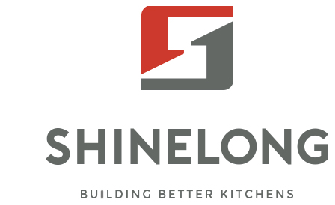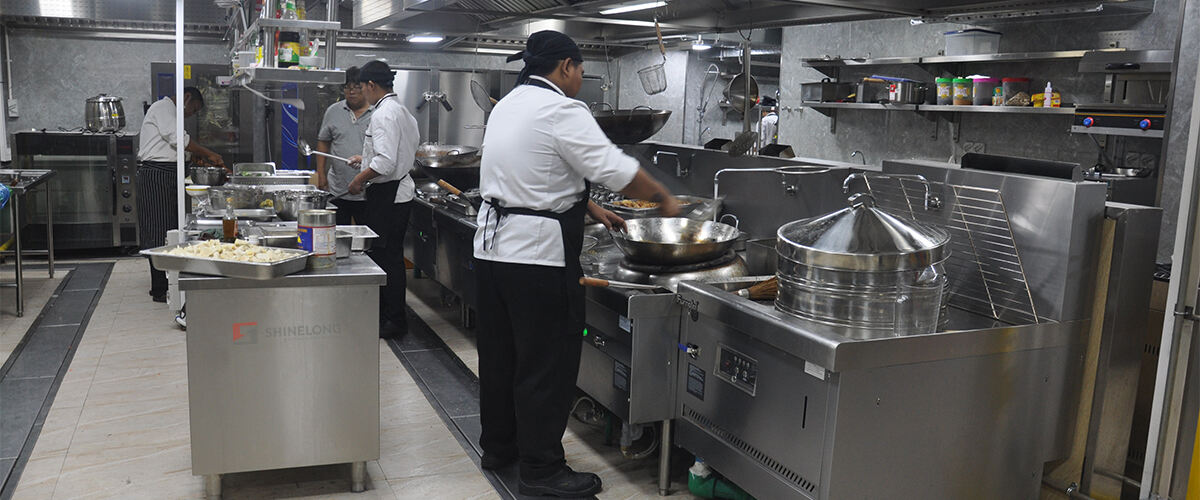News
Institutional Kitchen: Everything You Need to Know
In institutional kitchens for public catering, there are many key factors to consider before starting a massive catering operation. From food preparation to plating for the public, the primary responsibility of an institutional kitchen is to balance high quantity meal production with strict hygiene standards, food safety, and compliance with local regulations—all while ensuring consistent food quality.
Building a practical and efficient institutional kitchen may sound challenging—but that's where Shinelong's advantages lie. With over 20 years of experience in delivering turnkey commercial kitchen solutions, we’ve successfully completed more than 3,000 kitchen projects across 120+ countries.
In this article, we’ll break down what an institutional kitchen is, how to set one up, and the key challenges you may face during the construction process.
What Is an Institutional Kitchen?
An institutional kitchen is a type of commercial kitchen designed for mass catering operations, providing a large quantity of meals daily (typically more than 500 meals per day) with a focus on safety and service efficiency.
For a deeper understanding of their capacity, they can be divided into two main categories: smaller-scale operations that cater to 100 to 1,000 guests daily, and larger ones that serve over 1,000 diners per day. A typical institutional kitchen is, on average, capable of catering for around 500 people daily.
The core difference between an institutional kitchen and a commercial kitchen lies in the food service goals: the former focuses on nutrition and food quality consistency, while the latter emphasizes cuisine diversity and dining experience.
Different between the two
| Types | Institutional Kitchen | Commercial Kitchen |
| Service Target | Fixed groups like: students, patients, staff |
General public, walk-in customers |
| Food Features | Balanced, safe, nutritious and large quantity output | Flavor-focused, diversity |
| Kitchen Layout | Large-scale production, assembly-oriented | Zoned layout, designed for aesthetics and variety |
| Dining Rhythm | Fixed meal times, | On-demand orders, dynamic pace |
Which Food Services Require an Institutional Kitchen?
Education Food Service
From K-12 schools to university dining halls, education authorities are responsible for providing meals to hundreds or even thousands of students and staff each day. Meals must be nutritious, balanced, and served on time—typically within a rapid 30–45 minute window—often managed in a canteen kitchen using standardized institutional food service models.
Healthcare Food Service
No matter in hospitals or healthcare centers, healthcare kitchens serve patients, the aged, and medical staff with meals that prioritize hygiene, nutritional integrity, and therapeutic consistency. These hospital kitchens play a critical role in supporting recovery and well-being, requiring specialized hospital kitchen equipment that ensures safe, soft-textured, and precisely portioned meals.
Canteen Food Service
In manufacturing factories, corporate parks, or government departments, canteens must deliver enormous meals efficiently during fixed break periods. With productivity as a priority, commercial kitchen design should improve the efficiency of workflow, and effective institutional kitchen solutions often involve industrial cooking equipment such as tilting braising pans and large-capacity boiling soup kettles.
Contract Food Service
Contract catering is third-party kitchen operators providing mass catering services to institutions or organizations—ranging from colleges to enterprises—over a fixed term. Contract food service kitchens must prioritize consistency, sustainability, and cost-efficiency, often requiring adaptable layouts and multi-functional equipment like programmable combi ovens and high-efficiency dishwashers.
Common Commercial Kitchen Equipment in Institutional Kitchens
Cooking Equipment:
- Chinese Wok Range
- Tilting Frying Pan
- Steamer Cabinet
- Combi Oven
Food Processing Equipment:
- Dough Mixer
- Vegetable Cutter
- Bone Saw Machine
- Meat Grinder
- Meat Marinating Machine
Storage Solutions:
- Walk-in Cold Room
- Stainless Steel Shelving
- Upright Refrigerator
- Undercounter Refrigerator
Cleaning & Service Equipment:
- Conveyor Dishwasher
- Exhaust Hood & Ventilation System
- Food Serving Counter
- Portioning Station
5 Essential Steps to Build an Institutional Kitchen
Step 1 – Define the Kitchen Capacity and Menu
Before planning can even take place, service capacity and scope of menu must be considered. Are you starting a catering service for 100-1,000 diners per day, or do you want to operate on a large scale that handles over 1,000 people? That's a serious question.
When you partner with a leading commercial kitchen solution supplier like Shinelong, they also need to know the catering capacity of your institutional kitchen so that we can offer a more suitable solution for you. Additionally, your mass feeding strategy must be compatible with the types and consistency of meals under a scalable institution-style food service system.
Step 2 – Institutional Kitchen Layout and Workflow Design
Effective commercial kitchen design is simply making the most of flow—dividing raw and finish zones, reducing cross-traffic, and positioning stations ergonomically. A well-designed commercial layout has a direct effect on speed, hygiene, and labor effectiveness. For example, an assembly line kitchen or galley layout is a good option.
Step 3 – Select the Right Institutional Kitchen Equipment
Equipment needs to be matched to your space and your menu list, from steaming and boiling to holding and blast chilling. Selecting robust, high-capacity industrial kitchen equipment from trustworthy suppliers like Shinelong is the solid basis for long-term kitchen performance.
Step 4 – Installation and Commissioning
Timely and professional kitchen setup is crucial—especially for contract food service kitchens under project deadlines. Shinelong provides integrated commercial kitchen installation services, covering delivery, assembly, and performance testing to get operations up and running smoothly.
Step 5 – Continuing Maintenance and Staff Training
Preventive maintenance and periodic team training provide consistency and safety. Institutional kitchen solutions from our company also involve operation manuals, and kitchen safety & training programs designed specifically for any size of caterer operation.
What are the challenges in setting up an institutional kitchen?
Limited Local Resources for Equipment and Installation
In many developing regions, reliable equipment sourcing and qualified installation teams are difficult to find. Shinelong offers full-package solutions—including engineering, design, and a dedicated on-site crew—as a trusted cooking equipment supplier and industrial cooking equipment manufacturer for over 120 countries.
Equipment Downtime That Disrupts Meal Schedules
When your kitchen halts, operations collapse—especially with tight mass catering schedules. Shinelong delivers wholesale Chinese cooking equipment known for stability and provides responsive maintenance services to reduce downtime and ensure uninterrupted foodservice flow.
Inconsistent Output During Peak Volume
Handling peak service hours or surging meal demand requires more than manpower—it requires strategic capacity planning. Shinelong specializes in kitchen designs focused on output efficiency, supporting high-volume kitchens with advanced industrial kitchen equipment that meets continuous production demands.
Safety Risks from Equipment Failure or Misuse
With high-pressure, high-temperature cooking environments, poor-quality machines or untrained staff pose serious hazards. Shinelong only supplies CE-certified commercial equipment, and we provide on-site training to ensure safe operation across all kitchen roles.
Unreliable Suppliers with Bad Products
Choosing the wrong vendor often leads to mismatched specs, hidden costs, and service gaps. As a cooking equipment supplier, Shinelong operates as both a source manufacturer and a global project expert—offering transparent pricing and proven reliability in every kitchen project we deliver.
FAQs
1. What is an institutional kitchen?
An institutional kitchen is a large-scale commercial kitchen designed to prepare an average of 500+ meals daily for public catering sectors like hospitals, schools, and corporate canteens. It focuses on efficiency, consistency, and compliance with strict hygiene standards.
2. What is the typical layout of an institutional kitchen?
The most suitable designs are the assembly line layout for improving the efficiency of heavy-duty production and the galley layout for space efficiency. Both ensure smooth workflow, reduced cross-traffic, and faster service in mass catering operations.
3. What are the most common equipment in an institutional kitchen?
Depending on the facility—whether a hospital, college, sports arena, or government canteen—core equipment includes Chinese wok ranges, combi ovens, tilting frying pans, walk-in cold rooms, conveyor dishwashers, and specialized hospital kitchen equipment.
4. How to choose the right commercial kitchen equipment?
At Shinelong, we match equipment to your menu, production volume, and local cooking styles, following global foodservice standards. As an industrial cooking equipment manufacturer and wholesale Chinese cooking equipment supplier, we ensure durability, efficiency, and CE certification.
5. How to plan an institutional kitchen?
Planning starts with defining kitchen space and service capacity, menu, designing an optimal layout, selecting reliable institutional kitchen equipment, and ensuring proper installation. Shinelong provides turnkey institutional kitchen solutions with safety, workflow, and local standards as top priorities.
6. How do you offer your turnkey commercial kitchen solution?
We tailor solutions based on your service size—100–1,000 guests or over 1,000 guests—covering design, equipment supply, installation, and training. This ensures your kitchen meets operational demands from day one, anywhere in the world.
 After-Sales:
After-Sales:
 EN
EN
 AR
AR
 HR
HR
 NL
NL
 FI
FI
 FR
FR
 DE
DE
 EL
EL
 HI
HI
 IT
IT
 PT
PT
 RO
RO
 RU
RU
 ES
ES
 TL
TL
 ID
ID
 SL
SL
 VI
VI
 ET
ET
 MT
MT
 TH
TH
 FA
FA
 AF
AF
 MS
MS
 IS
IS
 MK
MK
 HY
HY
 AZ
AZ
 KA
KA
 UR
UR
 BN
BN
 BS
BS
 KM
KM
 LO
LO
 LA
LA
 MN
MN
 NE
NE
 MY
MY
 UZ
UZ
 KU
KU












